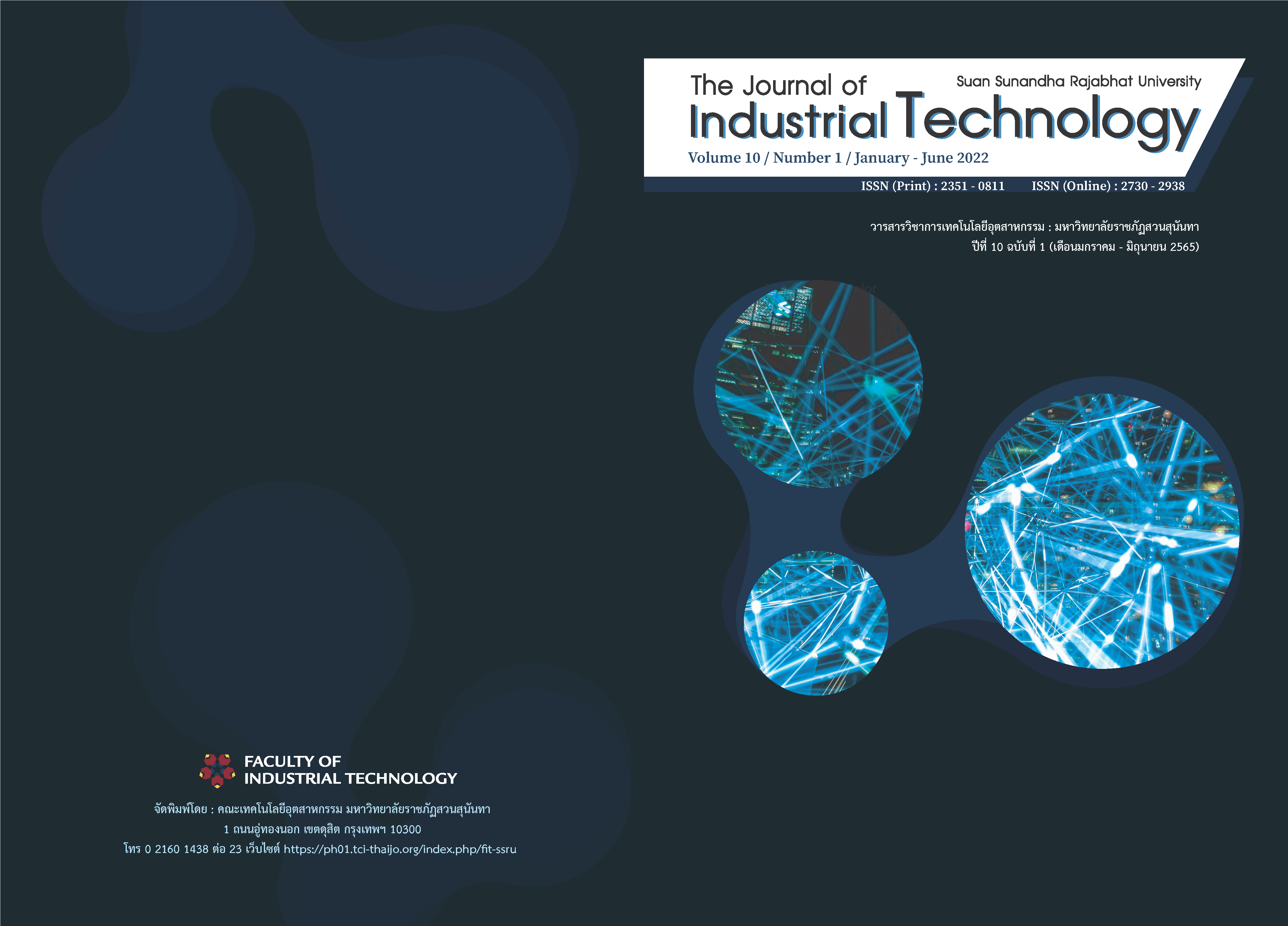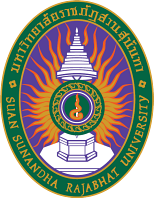Developing Screen Printing Ink from Natural Materials Using Tamarind Seeds as Mordant and Kangplakreua fruits and Ebony
Keywords:
หมึกพิมพ์สกรีน, เมล็ดมะขาม, ผลก้างปลาเครือ, ผงมะเกลือ, ค่าความดำAbstract
This research employed an experimental approach with 2 objectives: 1) to develop screen printing ink from tamarind seeds as mordant and Kangplakreua fruit and ebony powder as colorants; and 2) to analyze the adhesive property of tamarind seed mordant and Kangplakreua and ebony colorants. The experiment to prepare tamarind seed screen printing ink from tamarind seed powder used ingredients of water and tamarind seed powder at proportion of 5g, 10g, and 15 g of tamarind seed power in 100 ml water. Two color screen printing inks were prepared; first was purple color ink using Kangplakreua fruit as colorant with the proportion of 100 ml water: 10 g tamarind seed powder: 10 g, 20 g, 30 g, 40 g, 50 g Kangplakreua fruit. Second was black color ink using ebony powder as colorant with the proportion of of 100 ml water: 10 g tamarind seed powder: 10 g, 20 g, 30 g, 40 g, 50 g ebony powder. The prepared ink with different proportions was printed on cotton fabric by screen printing, then measured CIE L*a*b* using spectrophotometer once a day for seven days and test wash fastness by washing 5 times and measured CIE L*a*b* and ink density. The research results found that the proportion of tamarind seed powder used as adhesive at 10 g in 100 ml water gave the most sharp print image; Ink flow values 0.33 cm/min, 2.17 cm/min and 8.57 cm/min.; and ink viscosity was 1037 mPas. The purple ink used Kangplakreua fruit as colorant of the proportion of 100 ml water: 10 g. tamarind seed powder: 30 g Kangplakreua fruit gave the most sharp, smooth and even-colored print area; CIEL*a*b* value of L* 63.75 a*2.89 b* -5.08 and ink density at 1.78. The black ink used ebony powder as colorant of the proportion of 100 ml water: 10 g. tamarind seed powder: 30 g ebony powder gave smooth and sharp print image; CIEL*a*b* valule of L* 63.75 a*2.89 b* -5.08 and ink density at 1.83. The result of the color fastness of Kangplakreua fruit colorant ink found that after the first wash L* changed to higher lightness, b* changed to more blueness and print density reduced to 1.45. For the ebony powder colorant ink, it was found that after the first wash, L* changed to higher lightness, b* changed to less blueness and print intensity reduced to 1.50.
References
ChanThip Suesat. (16 June 2010). Chemicals in the textile industry. [Online]. Available: http://www.chemtrack.org/News-Detail.asp?TID=4&ID=24
Viorica Cazac, Jana Cîrja, Emilia Balan and Cristina Mohora, “The study of the screen printing quality depending on the surface to be printed,” 22nd International Conference on Innovative Manufacturing Engineering & Energy (IManE&E 2018), Chisinau, Moldova. vol. 178, 31 May - 2 June 2018, pp. 1-6.
Wichan Wanphonthong. “Dyeing with Natural Colors” Journal of the Department of Science Service, vol. 53, no. 168, pp. 35-37, May 2005.
Helmut Kipphan, Handbook of Print Media, 1st ed. Germany: Springer-Verlag Berlin Heidelberg, 2001.
Pratoomtong Trirat, “Screen ink, Development of screen inks from natural mordant and colorant,” Art and Architecture Journal Naresuan University, vol. 8, no. 1, January - June 2017. pp. 182-195,
Wirunporn Srimuang and Chanasda Chullasthira, “An Extracted Substance of Tamarind Seed for Design Creation on Cotton Fabric,” National Academic Conference “Homepoom No. 3 : Wisdom to the Future : Wisdom to the Future” Faculty of Architecture Khon Kaen University Thailand, 15-16 June 2017, pp. 457-466.
Wancheng Sittikijyothin. (2016). Physicochemical properties of gum extracted from seeds found in Thailand. [Online]. Available: https://doi.nrct.go.th/ListDoi/listDetail?Resolve_DOI=10.14457/BUU.res.2011.53
Downloads
Published
How to Cite
Issue
Section
License
Copyright (c) 2022 Faculty of Industrial Technology, Suan Sunandha Rajabhat University

This work is licensed under a Creative Commons Attribution-NonCommercial-NoDerivatives 4.0 International License.
บทความที่ได้รับการตีพิมพ์เป็นลิขสิทธิ์ของคณะเทคโนโลยีอุตสาหกรรม มหาวิทยาลัยราชภัฎสวนสุนันทา
ข้อความที่ปรากฏในบทความแต่ละเรื่องในวารสารวิชาการเล่มนี้เป็นความคิดเห็นส่วนตัวของผู้เขียนแต่ละท่านไม่เกี่ยวข้องกับมหาวิทยาลัยราชภัฎสวนสุนันทา และคณาจารย์ท่านอื่นๆในมหาวิทยาลัยฯ แต่อย่างใด ความรับผิดชอบองค์ประกอบทั้งหมดของบทความแต่ละเรื่องเป็นของผู้เขียนแต่ละท่าน หากมีความผิดพลาดใดๆ ผู้เขียนแต่ละท่านจะรับผิดชอบบทความของตนเองแต่ผู้เดียว








